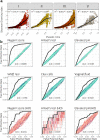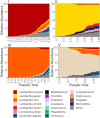A manifold-based framework for studying the dynamics of the vaginal microbiome
- PMID: 38102172
- PMCID: PMC10724123
- DOI: 10.1038/s41522-023-00471-8
A manifold-based framework for studying the dynamics of the vaginal microbiome
Abstract
The vaginal microbiome plays a crucial role in our health. The composition of this community can be classified into five community state types (CSTs), four of which are primarily consisted of Lactobacillus species and considered healthy, while the fifth features non-Lactobacillus populations and signifies a disease state termed Bacterial vaginosis (BV), which is associated with various symptoms and increased susceptibility to diseases. Importantly, however, the exact mechanisms and dynamics underlying BV development are not yet fully understood, including specifically possible routes from a healthy to a BV state. To address this gap, this study set out to characterize the progression from healthy- to BV-associated compositions by analyzing 8026 vaginal samples and using a manifold-detection framework. This approach, inspired by single-cell analysis, aims to identify low-dimensional trajectories in the high-dimensional composition space. It further orders samples along these trajectories and assigns a score (pseudo-time) to each analyzed or new sample based on its proximity to the BV state. Our results reveal distinct routes of progression between healthy and BV states for each CST, with pseudo-time scores correlating with community diversity and quantifying the health state of each sample. Several BV indicators can also be successfully predicted based on pseudo-time scores, and key taxa involved in BV development can be identified using this approach. Taken together, these findings demonstrate how manifold detection can be used to successfully characterize the progression from healthy Lactobacillus-dominant populations to BV and to accurately quantify the health condition of new samples along the route of BV development.
© 2023. The Author(s).
Conflict of interest statement
The authors declare no competing interests.
Figures





Update of
-
A Manifold-Based Framework for Studying the Dynamics of the Vaginal Microbiome.bioRxiv [Preprint]. 2023 Sep 6:2023.09.06.556518. doi: 10.1101/2023.09.06.556518. bioRxiv. 2023. Update in: NPJ Biofilms Microbiomes. 2023 Dec 15;9(1):102. doi: 10.1038/s41522-023-00471-8. PMID: 37732273 Free PMC article. Updated. Preprint.
Similar articles
-
A Manifold-Based Framework for Studying the Dynamics of the Vaginal Microbiome.bioRxiv [Preprint]. 2023 Sep 6:2023.09.06.556518. doi: 10.1101/2023.09.06.556518. bioRxiv. 2023. Update in: NPJ Biofilms Microbiomes. 2023 Dec 15;9(1):102. doi: 10.1038/s41522-023-00471-8. PMID: 37732273 Free PMC article. Updated. Preprint.
-
Vaginal microbiome.Ceska Gynekol. 2018 Winter;83(5):371-379. Ceska Gynekol. 2018. PMID: 30848142 Review. English.
-
Single-Molecule Approach to 16S rRNA for Vaginal Microbiome Signatures in Response to Metronidazole Treatment.Microbiol Spectr. 2023 Jun 15;11(3):e0170622. doi: 10.1128/spectrum.01706-22. Epub 2023 May 18. Microbiol Spectr. 2023. PMID: 37199621 Free PMC article.
-
Dietary macronutrient intake and molecular-bacterial vaginosis: Role of fiber.Clin Nutr. 2020 Oct;39(10):3066-3071. doi: 10.1016/j.clnu.2020.01.011. Epub 2020 Jan 29. Clin Nutr. 2020. PMID: 32033845 Free PMC article.
-
[Characteristics and physiologic role of female lower genital microbiome].Orv Hetil. 2023 Jun 18;164(24):923-930. doi: 10.1556/650.2023.32791. Print 2023 Jun 18. Orv Hetil. 2023. PMID: 37330978 Review. Hungarian.
References
MeSH terms
Grants and funding
LinkOut - more resources
Full Text Sources
Miscellaneous

